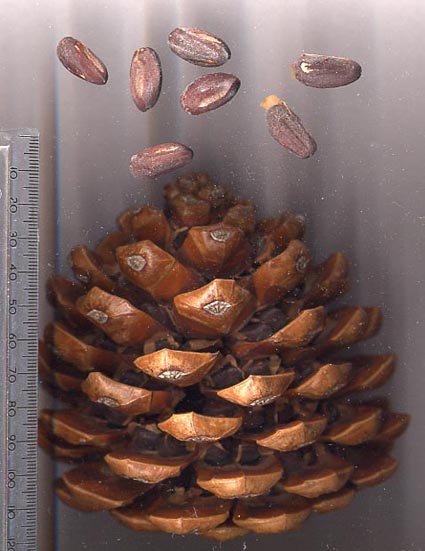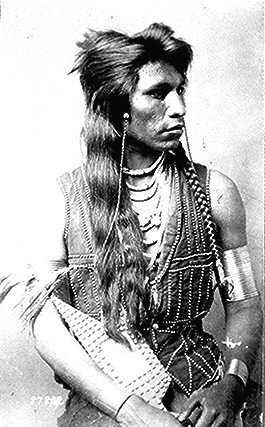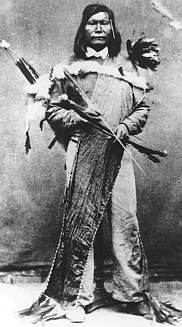|
Lovelock Paiute Tribe Of The Lovelock Indian Colony, Nevada
The Lovelock Paiute Tribe of the Lovelock Indian Colony is a federally recognized tribe of Northern Paiute Indians in Pershing County, Nevada.Pritzker, 226 Reservation The Lovelock Paiute Tribe has a federal reservation, the Lovelock Indian Colony, at in Pershing County. The reservation was established in 1907 and is . In 1990 80 tribal members lived on the reservation. In 1992, 110 people were enrolled in the tribe. The tribe's headquarters is located in Lovelock, Nevada. Sandra Winap is the tribal chairperson of a five-person tribal council. There is also a tribal police force consisting of one police chief and two officers. Tribal history Different bands of Northern Paiutes took the name of their principal food and those living in the area of present-day Lovelock called themselves Koop Ticutta, ground squirrel eaters. Other meats included jackrabbits, groundhogs, ducks, geese and fish. There were also plenty of wild vegetables and fruits to gather such as choke berries, pine ... [...More Info...] [...Related Items...] OR: [Wikipedia] [Google] [Baidu] |
Northern Paiute Language
Northern Paiute , endonym Numu, also known as Paviotso, is a Western Numic language of the Uto-Aztecan family, which according to Marianne Mithun had around 500 fluent speakers in 1994. ''Ethnologue'' reported the number of speakers in 1999 as 1,631. It is closely related to the Mono language. Phonology Northern Paiute's phonology is highly variable, and its phonemes have many allophones. Consonants Vowels Language revitalization In 2005, the Northwest Indian Language Institute of the University of Oregon formed a partnership to teach Northern Paiute and Kiksht in the Warm Springs Indian Reservation schools. In 2013, Washoe County, Nevada became the first school district in Nevada to offer Northern Paiute classes, offering an elective course in the language at Spanish Springs High School. Classes have also been taught at Reed High School in Sparks, Nevada. Elder Ralph Burns of the Pyramid Lake Paiute Reservation worked with University of Nevada, Reno linguist ... [...More Info...] [...Related Items...] OR: [Wikipedia] [Google] [Baidu] |
Pine Nuts
Pine nuts, also called piñón (), pinoli (), pignoli or chilgoza (), are the edible seeds of pines (family Pinaceae, genus ''Pinus''). According to the Food and Agriculture Organization, only 29 species provide edible nuts, while 20 are traded locally or internationally owing to their seed size being large enough to be worth harvesting; in other pines, the seeds are also edible, but are too small to be of notable value as a human food. Species and geographic spread In Asia, two species in particular are widely harvested: Korean pine (''Pinus koraiensis'') in northeast Asia (the most important species in international trade) and chilgoza pine (''Pinus gerardiana'') in the western Himalaya. Four other species, Siberian pine (''Pinus sibirica''), Siberian dwarf pine (''Pinus pumila''), Chinese white pine (''Pinus armandii'') and lacebark pine (''Pinus bungeana''), are also used to a lesser extent. Russia is the largest producer of ''Pinus sibirica'' nuts in the world, followed b ... [...More Info...] [...Related Items...] OR: [Wikipedia] [Google] [Baidu] |
Geography Of Pershing County, Nevada
Geography (from Greek: , ''geographia''. Combination of Greek words ‘Geo’ (The Earth) and ‘Graphien’ (to describe), literally "earth description") is a field of science devoted to the study of the lands, features, inhabitants, and phenomena of Earth. The first recorded use of the word γεωγραφία was as a title of a book by Greek scholar Eratosthenes (276–194 BC). Geography is an all-encompassing discipline that seeks an understanding of Earth and its human and natural complexities—not merely where objects are, but also how they have changed and come to be. While geography is specific to Earth, many concepts can be applied more broadly to other celestial bodies in the field of planetary science. One such concept, the first law of geography, proposed by Waldo Tobler, is "everything is related to everything else, but near things are more related than distant things." Geography has been called "the world discipline" and "the bridge between the human and th ... [...More Info...] [...Related Items...] OR: [Wikipedia] [Google] [Baidu] |
American Indian Reservations In Nevada
American(s) may refer to: * American, something of, from, or related to the United States of America, commonly known as the "United States" or "America" ** Americans, citizens and nationals of the United States of America ** American ancestry, people who self-identify their ancestry as "American" ** American English, the set of varieties of the English language native to the United States ** Native Americans in the United States, indigenous peoples of the United States * American, something of, from, or related to the Americas, also known as "America" ** Indigenous peoples of the Americas * American (word), for analysis and history of the meanings in various contexts Organizations * American Airlines, U.S.-based airline headquartered in Fort Worth, Texas * American Athletic Conference, an American college athletic conference * American Recordings (record label), a record label previously known as Def American * American University, in Washington, D.C. Sports teams Soccer * Ba ... [...More Info...] [...Related Items...] OR: [Wikipedia] [Google] [Baidu] |
Adrian C
Adrian is a form of the Latin given name Adrianus or Hadrianus. Its ultimate origin is most likely via the former river Adria from the Venetic and Illyrian word ''adur'', meaning "sea" or "water". The Adria was until the 8th century BC the main channel of the Po River into the Adriatic Sea but ceased to exist before the 1st century BC. Hecataeus of Miletus (c.550 – c.476 BC) asserted that both the Etruscan harbor city of Adria and the Adriatic Sea had been named after it. Emperor Hadrian's family was named after the city or region of Adria/Hadria, now Atri, in Picenum, which most likely started as an Etruscan or Greek colony of the older harbor city of the same name. Several saints and six popes have borne this name, including the only English pope, Adrian IV, and the only Dutch pope, Adrian VI. As an English name, it has been in use since the Middle Ages, although it did not become common until modern times. Religion *Pope Adrian I (c. 700–795) *Pope Adrian II (792–872 ... [...More Info...] [...Related Items...] OR: [Wikipedia] [Google] [Baidu] |
Mark Raymond Harrington
Mark Raymond Harrington (July 6, 1882 – June 30, 1971) was curator of archaeology at the Southwest Museum from 1928 to 1964 and discoverer of ancient Pueblo structures near Overton, Nevada and Little Lake, California. Early life Harrington knew early the rigors and fascinations of academic life. The son of Rose Martha Smith Harrington and Mark Walrod Harrington, a professor of astronomy at the University of Michigan who also held appointments in botany, zoology and geology, he spent his childhood roaming the area around Ann Arbor, Mich., his hometown, learning tribal languages from Indian friends and, when his family moved to Mount Vernon, New York, excavating and collecting local artifacts, thus feeding an early and lifelong interest in Native American culture. Education and archaeological career When his father's poor health and mental illness forced him to drop out of school, Harrington took some of his finds to Frederic Ward Putnam, then the curator in anthropology at the ... [...More Info...] [...Related Items...] OR: [Wikipedia] [Google] [Baidu] |
Shoshone
The Shoshone or Shoshoni ( or ) are a Native American tribe with four large cultural/linguistic divisions: * Eastern Shoshone: Wyoming * Northern Shoshone: southern Idaho * Western Shoshone: Nevada, northern Utah * Goshute: western Utah, eastern Nevada They traditionally speak the Shoshoni language, part of the Numic languages branch of the large Uto-Aztecan language family. The Shoshone were sometimes called the Snake Indians by neighboring tribes and early American explorers. Their peoples have become members of federally recognized tribes throughout their traditional areas of settlement, often co-located with the Northern Paiute people of the Great Basin. Etymology The name "Shoshone" comes from ''Sosoni'', a Shoshone word for high-growing grasses. Some neighboring tribes call the Shoshone "Grass House People," based on their traditional homes made from ''sosoni''. Shoshones call themselves ''Newe'', meaning "People".Loether, Christopher"Shoshones."''Encyclopedia of the Gr ... [...More Info...] [...Related Items...] OR: [Wikipedia] [Google] [Baidu] |
Sarah Winnemucca
Sarah Winnemucca Hopkins ( – October 17, 1891) was a Northern Paiute author, activist (lecturer) and educator (school organizer). Her maiden name is Winnemucca. Her Northern Paiute language, Northern Paiute name was Thocmentony, also spelled Tocmetone, which translates as "Chelone (plant), Shell Flower. Sarah Winnemucca was born near Humboldt Lake, Nevada, into an influential Northern Paiute family who led their community in pursuing friendly relations with the arriving groups of Anglo-American settlers. She is the daughter of Chief Winnemucca of the Paiute nation and the granddaughter of Chief Truckee. At 16, Sarah studied at a Catholic school in San Jose, California. When the Paiute War erupted between the Pyramid Lake Paiute and the settlers, including some who were friends of the Winnemucca family, Sarah and some of her family traveled to San Francisco and Virginia City to escape the fighting. They made a living performing onstage as "A Paiute Royal Family." In 1865, while ... [...More Info...] [...Related Items...] OR: [Wikipedia] [Google] [Baidu] |
Tule
''Schoenoplectus acutus'' ( syn. ''Scirpus acutus, Schoenoplectus lacustris, Scirpus lacustris'' subsp. ''acutus''), called tule , common tule, hardstem tule, tule rush, hardstem bulrush, or viscid bulrush, is a giant species of sedge in the plant family Cyperaceae, native to freshwater marshes all over North America. The common name derives from the Nāhuatl word ''tōllin'' , and it was first applied by the early settlers from New Spain who recognized the marsh plants in the Central Valley of California as similar to those in the marshes around Mexico City. Tules once lined the shores of Tulare Lake in California, formerly the largest freshwater lake in the western United States. It was drained by land speculators in the 20th century. The expression "out in the tules" is still common, deriving from the dialect of old Californian families and meaning "where no one would want to live", with a touch of irony. The phrase is comparable to "out in the boondocks". ''Schoenoplectus ... [...More Info...] [...Related Items...] OR: [Wikipedia] [Google] [Baidu] |
Sweet Potatoes
The sweet potato or sweetpotato (''Ipomoea batatas'') is a dicotyledonous plant that belongs to the bindweed or morning glory family, Convolvulaceae. Its large, starchy, sweet-tasting tuberous roots are used as a root vegetable. The young shoots and leaves are sometimes eaten as greens. Cultivars of the sweet potato have been bred to bear tubers with flesh and skin of various colors. Sweet potato is only distantly related to the common potato (''Solanum tuberosum''), both being in the order Solanales. Although darker sweet potatoes are often referred to as "yams" in parts of North America, the species is not a true yam, which are monocots in the order Dioscoreales. Sweet potato is native to the tropical regions of the Americas. Of the approximately 50 genera and more than 1,000 species of Convolvulaceae, ''I. batatas'' is the only crop plant of major importance—some others are used locally (e.g., ''I. aquatica'' "kangkong"), but many are poisonous. The genus ''Ipomoea' ... [...More Info...] [...Related Items...] OR: [Wikipedia] [Google] [Baidu] |
Groundhog
The groundhog (''Marmota monax''), also known as a woodchuck, is a rodent of the family Sciuridae, belonging to the group of large ground squirrels known as marmots. The groundhog is a lowland creature of North America; it is found through much of the Eastern United States, across Canada and into Alaska. It was first scientifically described by Carl Linnaeus in 1758. The groundhog is also referred to as a chuck, wood-shock, groundpig, whistlepig, whistler, thickwood badger, Canada marmot, monax, moonack, weenusk, red monk, land beaver, and, among French Canadians in eastern Canada, siffleux. The name "thickwood badger" was given in the Northwest to distinguish the animal from the American badger, prairie badger. Monax (''Móonack'') is an Algonquian languages, Algonquian name of the woodchuck, which means "digger" (cf. Delaware languages, Lenape ''monachgeu''). Young groundhogs may be called chucklings. The groundhog, being a lowland animal, is exceptional among marmots. Oth ... [...More Info...] [...Related Items...] OR: [Wikipedia] [Google] [Baidu] |
English Language
English is a West Germanic language of the Indo-European language family, with its earliest forms spoken by the inhabitants of early medieval England. It is named after the Angles, one of the ancient Germanic peoples that migrated to the island of Great Britain. Existing on a dialect continuum with Scots, and then closest related to the Low Saxon and Frisian languages, English is genealogically West Germanic. However, its vocabulary is also distinctively influenced by dialects of France (about 29% of Modern English words) and Latin (also about 29%), plus some grammar and a small amount of core vocabulary influenced by Old Norse (a North Germanic language). Speakers of English are called Anglophones. The earliest forms of English, collectively known as Old English, evolved from a group of West Germanic (Ingvaeonic) dialects brought to Great Britain by Anglo-Saxon settlers in the 5th century and further mutated by Norse-speaking Viking settlers starting in the 8th and 9th ... [...More Info...] [...Related Items...] OR: [Wikipedia] [Google] [Baidu] |





